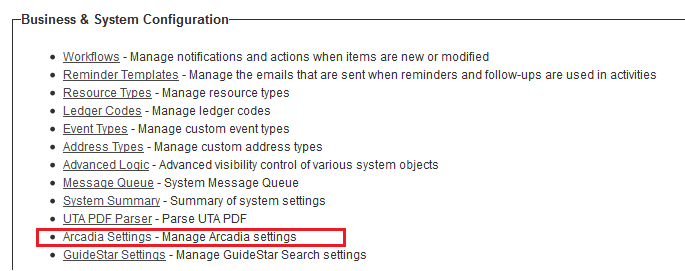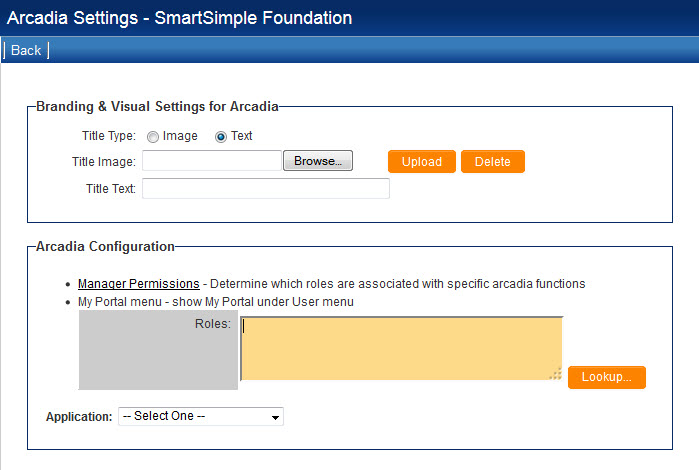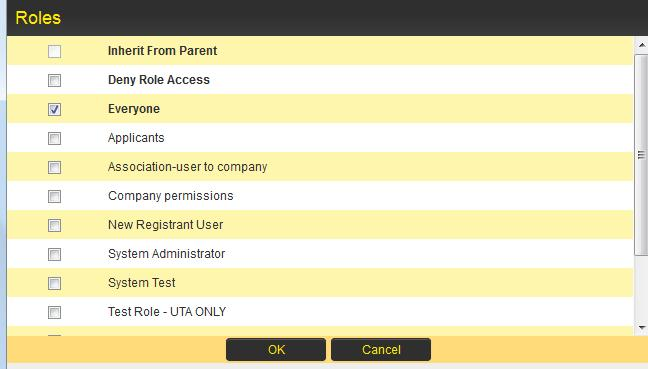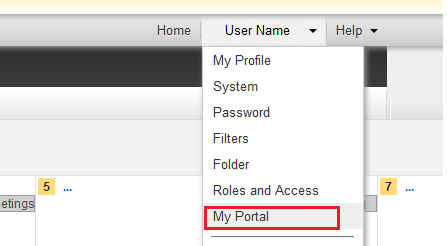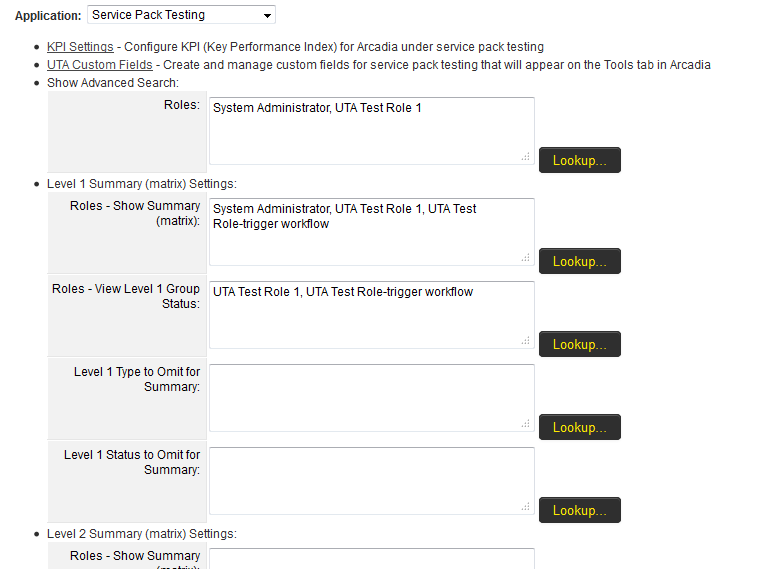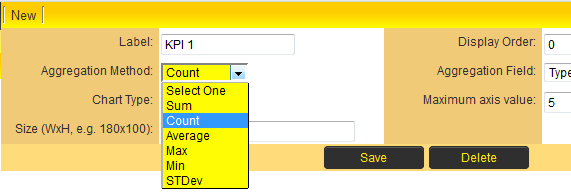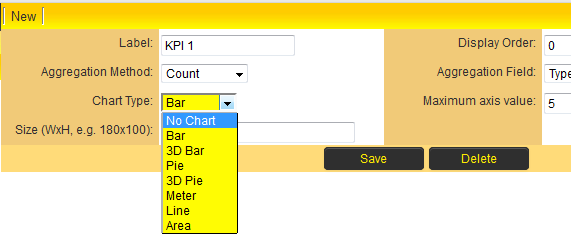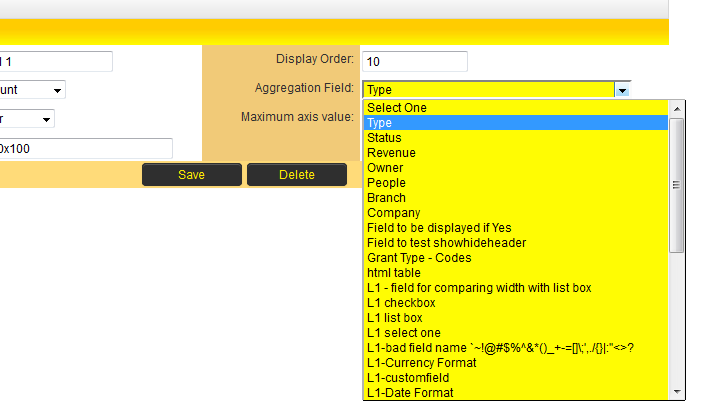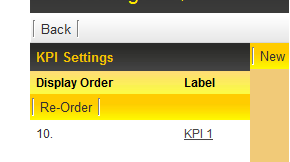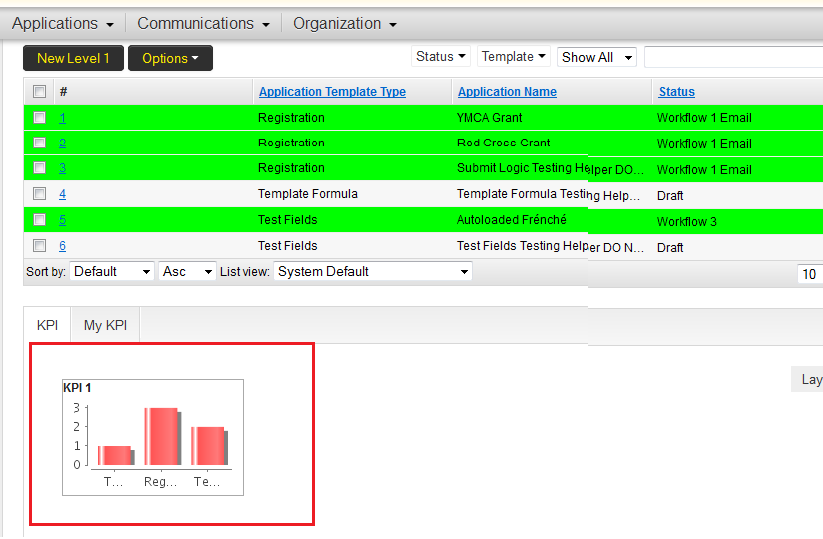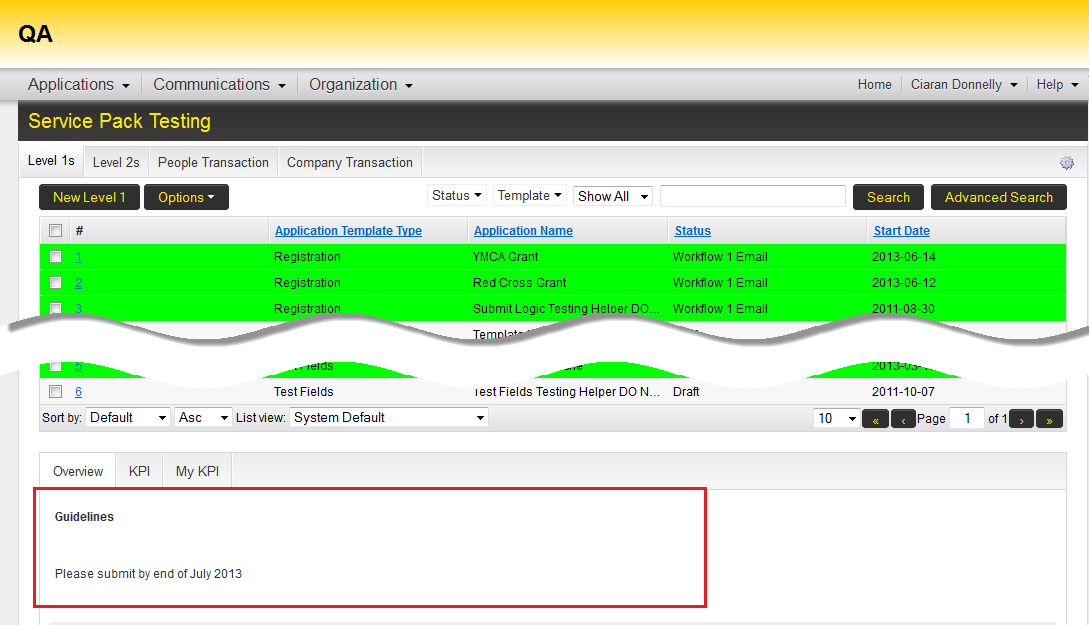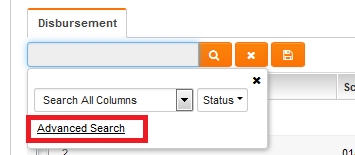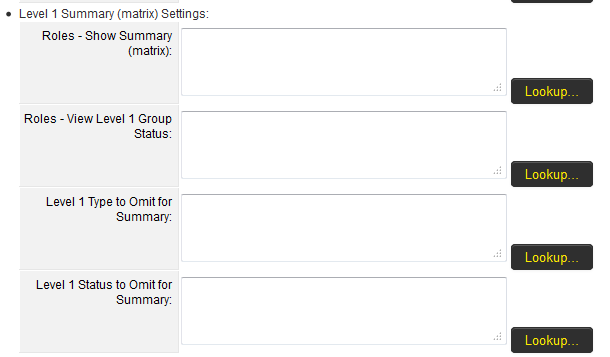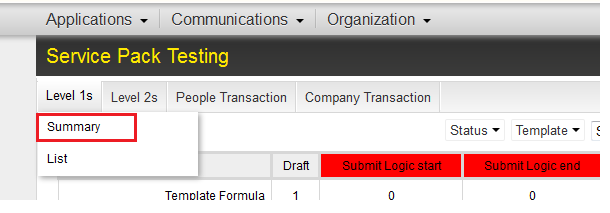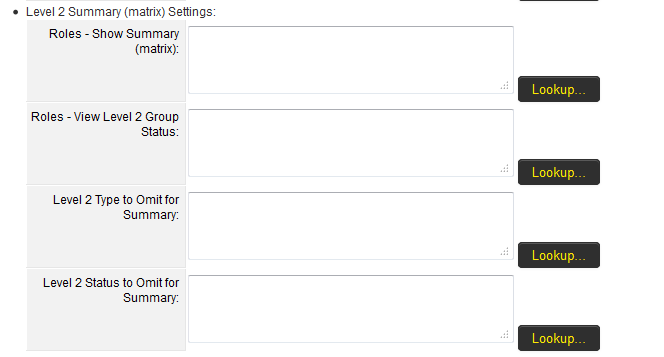Arcadia Settings
Contents
Configuring Arcadia
- Go to Global Settings > Business & System Configuration, and click on Arcadia Settings hyperlink.
- User is presented with the Arcadia Settings page.
- The Arcadia Settings page has a number of options to allow for configuration of the Arcadia Interface:
- Branding & Visual Settings for Arcadia - The "Title Type" settings determine the image or text shown in the top of your Arcadia interface.
- Manager Permissions - enabling role specific access to the Arcadia Interface, including ability to switch back to the Classic Interface.
- My Portal menu - enabling access to existing icon based Portal interfaces via the Arcadia Interface
- Application - allows for configuration of the Arcadia Interface specific to any UTA available on that instance.
Users in certain roles may already have access to the system via a portal interface, with a series of icons providing access to required information or functionality.
Continued access to these portal interfaces in the Arcadia interface is permitted through the use of the My Portal menu option.

This is configurable by following the steps below:
- Click on the Lookup button.
- In the resulting screen check the box against those roles that requires continued access to their portal interface, or check Everyone if all users in all roles should have access. Then click OK.
- The Roles field should now be populated with the roles selected.
- When a user in one of these roles logs into the system they will now have the option to view their portal interface by clicking on the drop-down option by their name and then selecting the My Portal option.
Application
The Application section allows for configuration of the Arcadia Interface specific to any UTA available on that instance.
This includes the ability to have cross-tabbed standard views with drill down options and KPIs for simplified presentation of important metrics.
- Select the UTA from the drop-down list.
- A number of additional options are now exposed to the end-user:
- KPI Settings
- UTA Custom Fields
- Show Advanced Search
- Level 1 Summary (matrix) Settings
- Level 2 Summary (matrix) Settings
- Tab Settings
KPI Settings
The KPI Settings section allows the configuration of KPI (Key Performance Index) specific to the selected UTA.
- Click on the KPI Settings hyperlink.
- This launches the KPI Settings section.
- Click on the New option to start the creation of a new KPI.
- Populate the Name field with descriptive text appropriate for the KPI being created.
- Select the Aggregation Method from the drop-down list. This controls how the data will be aggregated when presented via the KPI.
- Select the Chart Type from the drop-down list. This controls the type of chart used to represent the data.
- Populate the Display Order field with an appropriate numeric value. This will control the placement of the KPI on the screen, with lower display orders meaning that the KPI will appear closer to the top of KPI section.
- Select the Aggregation Field from the drop-down list. The drop-down will display the Standard Fields and Custom Fields within the selected UTA that the raw data will be aggregated against.
- Size field defaults to a width of 180 pixels and a length of 100 pixels. These values can be overwritten as necessary.
- Click Save
- The KPI will now appear to the left of the screen in the list of available KPIs.
- The KPI should now appear in the Arcadia interface for those roles with appropriate permissions.
UTA Custom Fields
This feature allows users to create and manage custom fields for the selected UTA that will appear in the Arcadia interface.
Common uses for this section may include creating guidelines for end-users or creating tabs to hold common information.
- Click on the UTA Custom fields hyperlink.
- In the resulting screen click the New tab to start adding custom fields.
- The New Custom Field window is displayed, including the various setting options specific to that field.
- Populate these settings as appropriate and click Save. See Custom Fields section for additional information on how to configure custom fields.
- If the Tab Name was not populated for the field it should appear at the top of UTA specific Arcadia interface for those roles with appropriate permissions.
- If the Tab Name was populated for the field it should appear at the bottom of UTA specific Arcadia interface for those roles with appropriate permissions. The field will only be visible after clicking on the Tab that is contained within.
Show Advanced Search
The Advanced Search feature enables quick and easy input of multiple search criteria including AND, OR and NOT operands.
It can be made available against individual UTAs based on an individuals role.
- Click on the Lookup button.
- In the resulting screen check the box against those roles that requires continued access to their portal interface, or check Everyone if all users in all roles should have access. Then click OK.
- The Advanced Search option should now appear in the Arcadia interface for those roles with appropriate permissions.
Level 1 Summary (matrix) Settings
There are 4 configurable options available:
- Roles - Show Summary (matrix)
- Roles - View Level 1 Group Status
- Level 1 Type to Omit for Summary
- Level 1 Status to Omit for Summary
Roles - Show Summary (matrix)
The Show Summary section provides access to cross-tabbed standard view of the level one, with drill down options.
It can be made available on a role by role basis, using the Lookup button to select those roles that can access the Summary section against the Level 1.
If a user logs in with a role that is permitted to see the Summary section against the Level 1 when they access the UTA in the Arcadia view they have the option to view the Summary section.
If a user logs in with a role that is not permitted to see the Summary section then they will not have the option to view the Summary section. Instead they only see the List View.
Roles - View Level 1 Group Status
The View Level 1 Group Status is used to restrict certain roles from seeing the exact status of level ones.
Instead they see a group status that masks multiple individual statuses within a single overall status.
This setting is used on conjunction with the Group Name field of the UTA Statuses.
Use the Lookup button to select those roles that should see the group status.
Level 1 Type to Omit for Summary
The Level 1 Type to Omit for Summary section is used to exclude certain Level 1 Types from the Summary Matrix.
This could include historic types that are no longer of interest to the organization.
Click on the Lookup button and select the Level 1 Types to be excluded, then click OK.
Leave the section blank if all Level 1 Types are to be included in the summary matrix
Level 1 Status to Omit for Summary
The Level 1 Status to Omit for Summary section is used to exclude certain Level 1 statuses from the Summary Matrix.
Click on the Lookup button and select the Level 1 statuses to be excluded, then click OK.
Leave the section blank if all Level 1 statuses are to be included in the summary matrix
Level 2 Summary (matrix) Settings
There are 4 configurable options available:
- Roles - Show Summary (matrix)
- Roles - View Level 2 Group Status
- Level 2 Type to Omit for Summary
- Level 2 Status to Omit for Summary
Roles - Show Summary (matrix)
The Show Summary section provides access to a cross-tabbed standard view of the level 2, with drill down options.
It can be made available on a role by role basis, using the Lookup button to select those roles that can access the Summary section.
If a user logs in with a role that is permitted to see the Level 2 Summary section when they access the UTA in the Arcadia view they have the option in the Level 2 to view the Summary section.
If a user logs in with a role that is not permitted to see the Level 2 Summary section then when they access the UTA in the Arcadia view they will not have the option to view the Summary section against the Level 2 and will instead see only the List View.
Roles - View Level 2 Group Status
The View Level 2 Group Status is used to restrict certain roles from seeing the exact status of level twos.
Instead they see a group status that masks multiple individual statuses within a single overall status.
This setting is used on conjunction with the Group Name field of the UTA Statuses.
Use the Lookup button to select those roles that should see the group status.
Level 2 Type to Omit for Summary
The Level 2 Type to Omit for Summary section is used to exclude certain Level 2 Types from the Summary Matrix.
This could include historic types that are no longer of interest to the organization.
Click on the Lookup button and select the Level 2 Types to be excluded, then click OK.
Leave the section blank if all Level 2 Types are to be included in the summary matrix
Level 2 Status to Omit for Summary
The Level 2 Status to Omit for Summary section is used to exclude certain Level 2 statuses from the Summary Matrix.
Click on the Lookup button and select the Level 2 statuses to be excluded, then click OK.
Leave the section blank if all Level 2 statuses are to be included in the summary matrix
Tab Settings
There are 4 configurable options available:
- Roles - Show KPI tab
- Roles - Show My KPI tab
- Roles - Show Reports tab
- Roles - Show Maps tab
Roles - Show KPI tab
The Show KPI tab is used to restrict certain roles from seeing the KPI tab.
Use the Lookup button to select those roles that will should see the KPI tab.
Roles - Show My KPI tab
The Show My KPI tab is used to restrict certain roles from seeing the My KPI tab.
Use the Lookup button to select those roles that will should see the MY KPI tab.
Roles - Show Reports tab
The Show Reports tab is used to restrict certain roles from seeing the Reports tab.
Use the Lookup button to select those roles that will should see the Reports tab.
Roles - Show Maps tab
The Show Maps tab is used to restrict certain roles from seeing the Maps tab.
Use the Lookup button to select those roles that will should see the Maps tab.
